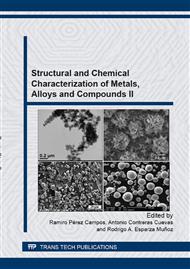[1]
P. Martínez Ortiz Y J. H. Espina Hernández, J. M. Hallen, R. Linares y Miranda, Caracterización de aceros API-5L por medio de la medición de ruido magnético, Barkhausen, Científica 14 (2010) 81-87.
Google Scholar
[2]
Z.Y. Liu, X.G. Li, Y.F. Cheng, Mechanistic aspect of near-neutral pH stress corrosion cracking of pipelines under cathodic polarization, Corrosion Science 55 (2011) 54-60.
DOI: 10.1016/j.corsci.2011.10.002
Google Scholar
[3]
A. Contreras, R. Galván-Martínez, R. Orozco-Cruz, Mechanical and environmental effects on stress corrosion cracking of low carbon pipeline steel in a soil solution, Materials and Design 35 (2012) 281-289.
DOI: 10.1016/j.matdes.2011.09.011
Google Scholar
[4]
I. A. Metwally, H.M. Al-Mandhari, A. Gastli, Z. Nadir, Factors affecting cathodic-protection interference, Engineering Analysis with Boundary Elements 31 ( 2007) 485-493.
DOI: 10.1016/j.enganabound.2006.11.003
Google Scholar
[5]
A. Eslami, B. Fang, R. Kania, B. Worthingham, J. Been, R. Eadie, W. Chen, Stress corrosion cracking initiation under the disbonded coating of pipeline steel in near-neutral pH environment, Corrosion Science 52 (2010) 3750-3756.
DOI: 10.1016/j.corsci.2010.07.025
Google Scholar
[6]
B.S. Delanty, J. O'Beirne, Major field study compares pipeline SCC with coatings, Oil and Gas Journal, Tulsa, OK, USA, 90 (1992) 39-44.
Google Scholar
[7]
A. Contreras, M. Salazar, A. Albiter, R. Galván, O. Vega, Assessment of stress corrosion cracking on pipeline steels weldments used in the petroleum industry by slow strain rate tests, Arc Welding, chapter 7, ed. Wladislav Sudnik, INTECH Open Access Publisher, First Publication, Croatia, 2011, 127-150.
DOI: 10.5772/26569
Google Scholar
[8]
Z. Velazquez, E. Guzman, M. Espinosa, A. Contreras, Stress corrosion cracking behavior of X60 in soil environment, Mater. Res. Soc. Symp. Proc., New York, 1242, (2010), pp.69-78 .
DOI: 10.1557/proc-1242-s4-p131
Google Scholar
[9]
NACE TM-0497, Measurement technique related to criteria for cathodic protection on underground or submerged metallic piping systems, NACE International, Houston, Tx, (2002) 1-28.
Google Scholar
[10]
ASTM G1, Standards practice for preparing, cleaning and evaluating corrosion test specimens. Annual book ASTM Standards, West Conshohocken, PA, 2009.
Google Scholar
[11]
P. R. Roberge, Handbook of Corrosion Engineering, McGraw-Hill, New York, 2000, 35-54.
Google Scholar
[12]
A. Eslami, B. Fang, R, Kania, et al, Stress corrosion cracking initiation under the disbonded coating of pipeline steel in near-neutral pH environment, Corrosion Science 52 (2010) 3750-3756.
DOI: 10.1016/j.corsci.2010.07.025
Google Scholar
[13]
Y.Y. Wu, P. Lambert, P. Mangat, F.J. O'Flaherty, Analysis of stray current induced by cathodic protection on steel-framed masonry structures, Sheffield Hallam University, Open Corrosion Journal 4 (2011) 34-39
DOI: 10.2174/1876503301104010034
Google Scholar
[14]
Z. Wua, J. H. Davidson, L. F. Francis, Effect of water chemistry on calcium carbonate deposition on metal and polymer surfaces, J. of Colloid and Interface Science 343 (2010) 176-187.
DOI: 10.1016/j.jcis.2009.11.031
Google Scholar
[15]
J.P Andreassen, R. Beck, M. Nergaard, Biomimetic type morphologies of calcium carbonate grown in absence of additives, Faraday Discuss 159 (2012) 247-261.
DOI: 10.1039/c2fd20056b
Google Scholar
[16]
Z.Y. Liu, X.G. Li, Y.F. Cheng, Electrochemical state conversion model for occurrence of pitting corrosion on a cathodically polarized carbon steel in a near-neutral pH solution, Electrochimica Acta 56 (2011) 4167-4175.
DOI: 10.1016/j.electacta.2011.01.100
Google Scholar


